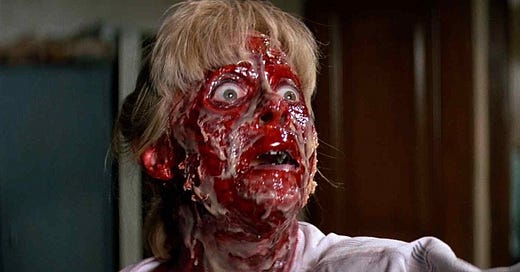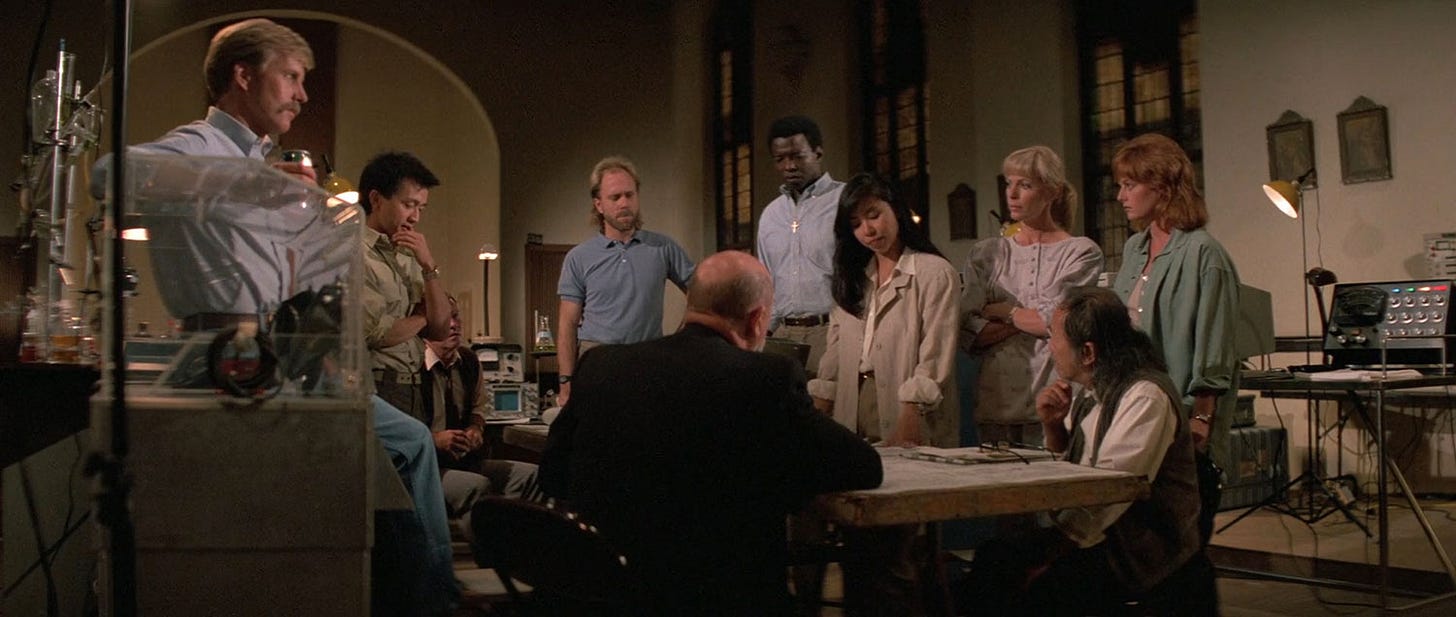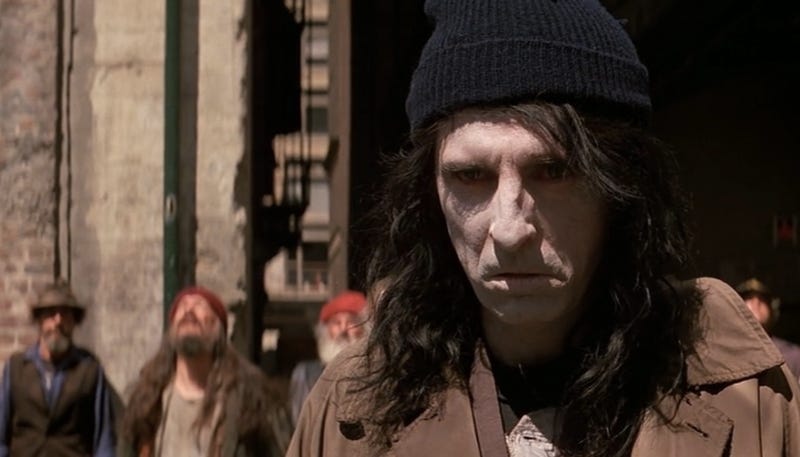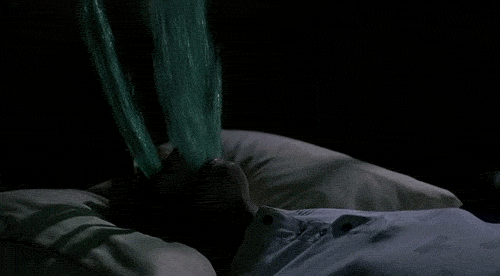We continue and, indeed, conclude our Halloween themed posts with a review of John Carpenter’s Prince of Darkness (1987). This film is the second of Carpenter’s apocalypse trilogy. The first is The Thing. The third is In the Mouth of Madness. Like children, the middle one doesn’t get the attention it deserves.
This is a great horror movie for three reasons. First, it’s seriously creepy. Second, it's surprisingly complex. Third, its opening sequence is a master class in visual storytelling.
But our first impression of the film is not visual - it’s audial. Carpenter is known for composing the soundtracks for his own films. As Rolling Stone wrote in 2014, Carpenter is “responsible for some of the most suspenseful and influential soundtracks this side of Bernard Herrmann.” His most famous is Halloween. “All I did was sit down at a piano and play octaves and went up a half-step. That’s the Halloween theme.”
He told Rolling Stone he keeps it simple. “In thrillers or horror films, you’re trying to create suspense, this sense of, ‘What’s coming?’ Think of the Jaws theme. It’s two notes. It keeps you in suspense.”
Prince of Darkness opens on an unsettling note. While the scenes that follow are fairly innocuous (such as a college student checking out a co-ed) the music informs us there is something more going on beneath the surface, something evil lurking just behind the veil. We will glimpse that evil later in the film.
While it is not devoid of dialogue, the opening keeps the conversation minimal. The story is instead told through images.
We see a priest die. He is holding a box. Later, a key is found in the box. We are shown a student checking out another and it is obvious he is smitten with her. A strange influence has taken hold of the world - bugs cluster together and the horned moon hovers above the sun. Another priest, having taken possession of the key, opens a locked door within an abandoned church. Later, the priest sits at a word processor. He is writing a letter. It is addressed to a physics professor at a university. The professor and the priest meet, the latter pleads for help.
The priest is called Loomis although he is never named in the movie. He is played by Donald Pleasence. Professor Birack is played by Victor Wong. He teaches theoretical physics. Most of the dialogue in the opening sequence is Birack introducing concepts of quantum physics to his grad students. He says:
Let's talk about our beliefs, and what we can learn about them. We believe nature is solid, and time a constant. Matter has substance and time a direction. There is truth in flesh and the solid ground. The wind may be invisible, but it's real. Smoke, fire, water, light: they're different, not as to stone or steel, but they're tangible. And we assume time is an arrow because it is as a clock - one second is one second for everyone. Cause precedes effect: fruit rots, water flows downstream. We're born, we age, we die. The reverse never happens. None of this is true! Say goodbye to classical reality, because our logic collapses on the subatomic level into ghosts and shadows.
Loomis brings Birack through the locked door in the abandoned church. As they travel down steps and through tunnels Loomis explains the Brotherhood of Sleep was a powerful sect of the Catholic Church which operated outside the Vatican’s knowledge. They had the tunnels built to hide an ancient book and a large canister of swirling green liquid.
Birack returns with a team of researchers from the university to investigate. Among them are Brian Marsh (Jameson Parker) and Catherine Danforth (Lisa Blout) who have recently fallen in love. There is also the wise-cracking Walter (Dennis Dun), radiologist Susan Cabot (Anne Howard), theologist Lisa (Ann Yen) and physicist Kelly (Susan Blanchard). The team spends an entire weekend at the church researching.
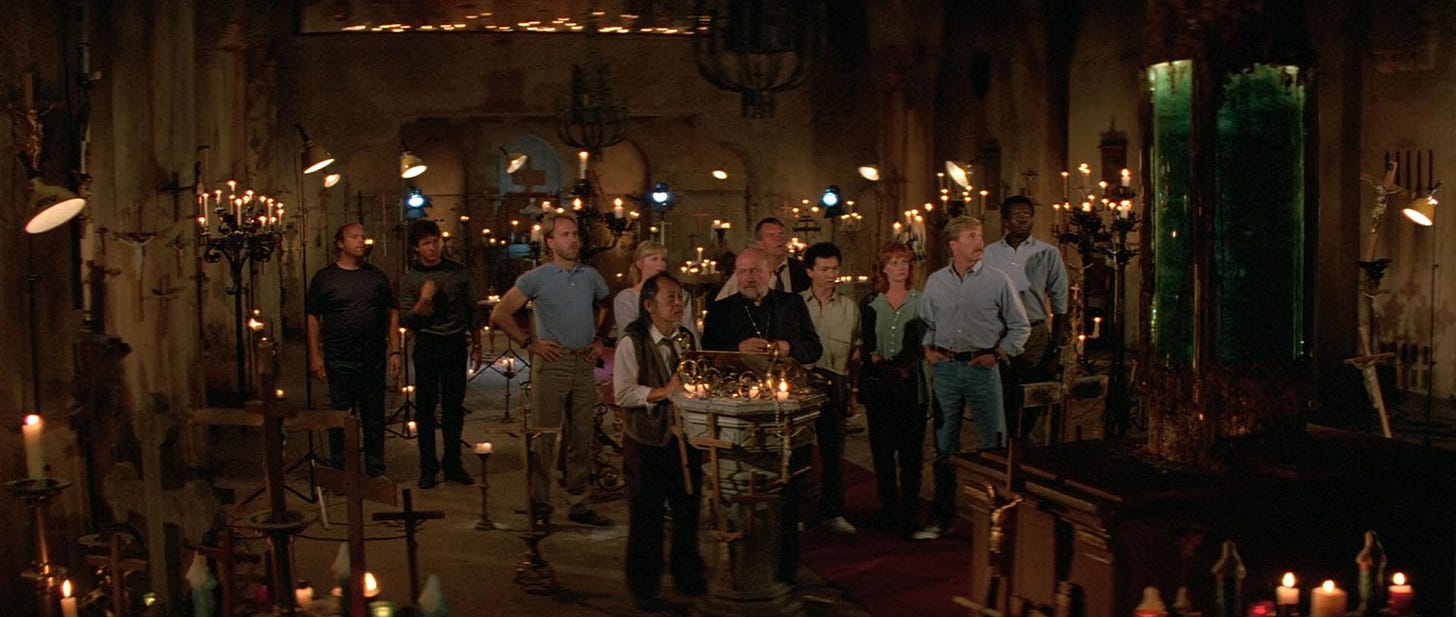
Horror isn’t only for creepy castles; it can be found in banal places. St. Godard’s church is unremarkable: Brutalist, perhaps, and dingy but something you’d pass without noticing. The setting is creepy because of its banality and decay.
Carpenter always emphasized realism. For example, he cast Roddy Piper in They Live because Piper was an “everyman.” Well, St. Godard’s could be an “every church.” Indeed, it could be the abandoned church in the rundown part of your town.
The homeless loiter around it, too. This is a very real thing, even today and especially in California where the church is located. Their odd behavior adds to the sense of evil that has pervaded this film since the very first note.
Carpenter further creates a sense of realism with bits of dialogue. There are too many to reproduce here and they’re all great, but this interaction is representative: an attractive blonde bumps into Frank Wyndham (Robert Grasmere) on her way out of the room. Evidently they know each other. Etchinson (Thom Bray) asks, “Frankie, who was that?” He replies, “Susan Cabot. Radiologist. Married.” Etchinson then asks, “Ah! How married?” A typical dude conversation.
One final point on realism before we continue. Each character reacts differently to the swirling mass of green liquid. Calder (Jessie Lawrence Ferguson) is visibly disturbed. When asked what’s going on he looks ill. “Something downstairs,” he says. Meanwhile, Walter and Wyndham are skeptical, the latter stating, “I hate to tell you guys, but this is real bullshit.”
Kelly doesn’t see what the big mystery is about. She wants to take direct samples and find out what the green stuff is. However, Brian informs her that differential equations have been found in the 2000 year old book. Walter points out that differential equations had not been invented yet. Brian poignantly replies, “Right.”
Father Loomis believes the liquid is Satan. He tells Birack, “It's your disbelief that powers him. Your stubborn faith in, in…common sense. It allows his deception. He lives in the smallest parts of it. In the atoms...smaller...invisible...he lives in all of it. In the sum of its parts.” Loomis theorizes that Satan is a subatomic entity where, to use Birack’s own words against him, “our logic collapses on the subatomic level into ghosts and shadows.” This is the precise place where science fails and faith must take precedence.
Loomis continues, “We must translate this book. You must prove it scientifically to convince the outside world.” Birack, however, resists. “The outside world doesn't want to hear this kind of bullshit. Just keep it locked away. You've already managed that for 2000 years.”
Lisa, the theologist, translates the book. It confirms what Loomis suspected: the green goo is Satan, imprisoned and sleeping...but sleeping no more. Jesus was of extraterrestrial origins and came to warn us. His warnings fell on deaf ears. The canister was kept secret by the Brotherhood of Sleep until a science could be invented to prove Jesus right. Satan, meanwhile, has a father who he will release into our world as soon as he can claim a human vessel. That vessel will be marked with an astrologer's staff.
Brian’s preliminary findings seem to support all this. He tells Birack, “A life form is growing out of pre-biotic fluids. It's not winding down into disorder, it's self-organizing. It's becoming something. What? An animal? A disease? What?” It is conscious. It has telekinesis. It also seems to be “Reaching out. Influencing. Changing things.” As Brian delivers this line to Catherine he looks at the window which is covered with earthworms.
The homeless are also affected by Satan’s “Influencing.” They have been amassing since early Friday morning when the research team first arrived. Kelly points out that they are schizophrenics but don’t follow the behavioral patterns associated with it. When Etchinson leaves he is murdered by a “Street Schizo” played by Alice Cooper. Yes, that Alice Cooper.
Susan goes downstairs to see the thing she has been carbon dating. It is 7 million years old. An amount of the green liquid escapes the canister. It drips upward, pooling on the ceiling. A jet of it sprays into Susan’s mouth. She becomes possessed. She kills Mullins (Dirk Blocker).
With the scientific evidence mounting against Birack, he entertains Loomis’ faith: “Suppose what your faith has said was essentially correct. Suppose there is a universal mind controlling everything: a god willing the behavior of every subatomic particle.” But he also pushes back: “Well, every particle has an antiparticle, its mirror image, its negative side. Maybe this universal mind resides in the mirror image instead of in our universe as we wanted to believe. Maybe he's anti-god, bringing darkness instead of light.”
God may not be our friend.
Anyone near the Brotherhood of Sleep has the same dream. They see the front of the church and a dark figure emerging from it. A distorted voice can be heard. The scientists determine that the dreams are a message - a warning - from the future. Tachyons are subatomic particles that travel faster than light. They also travel backwards through time. They could carry a message received as neural stimuli.
Meanwhile, Susan possesses other team members. First she gets Lisa. Together they get Calder. Before that, however, Calder witnesses Lisa typing on the computer, “I live! I live! I live!” and then, “You will not be saved by the Holy Ghost. You will not be saved by the god, Plutonium. In fact, YOU WILL NOT BE SAVED!”
I must confess I was confused by this, but others have suggested “the god, Plutonium” refers to the element and thus to the nuclear age, to science. Religion and science are inventions of Man. Satan is a third party that will destroy both.
Calder is more spiritual than the others. We’ve seen that he wears a cross. I believe his faith enables him to fight the possession...to a point. While singing “Amazing Grace,” he stabs himself in the throat with a bit of wood.
Susan and Lisa, however, are completely enthralled. They move the large canister into Kelly's room, where she sleeps unaware. Earlier, Kelly bruised her arm. That bruise has taken the shape of an astrologer’s staff.
The green fluid enters Kelly’s body. She swells up as if pregnant. Slowly, her body metabolizes the goo, and she mutates.
The surviving researchers barricade the rooms against their former colleagues turned attackers. Brian attempts to escape through a window, but the mob of “Street Schizos” advance on him like a horde of zombies. His frantic climb back through the window is one of the most terrifying things I have ever seen.
Loomis cowers in a utility room. The pillars of his faith have been toppled. He understands that the Catholic Church lied to the world. They knew that Satan was real, corporeal and that Evil is a substance which could be measured scientifically. Instead, the Church opted for a spiritual interpretation of Evil. It was easier that way; it kept Man at the center of the universe. Wiping tears away Loomis says, “Where are you…Christ? Where are you?”
Several hours later Kelly wakes up. She reaches through a mirror and pulls out the hand of her father, the anti-god, who resides in a mirror universe of darkness. Loomis picks up a fire axe. Muttering, “I could. I could,” he swings it at Kelly taking off her arm and then her head. But she is invulnerable. The arm grows back. She reattaches her own head.
The others are indisposed. Brian wrestles with Calder. Birack and Walter fight with Mullins, Lisa and Susan. Only Catherine is free to act. She tackles Kelly, and they both fall through the mirror. Loomis destroys it with the axe, closing the portal.
With Satan and the anti-god trapped in the mirror universe the world is presumed safe. However, Brian has the “dream” one more time. The indistinct voice can be heard fully. Watch the dream here. The figure emerging from St. Godard’s is Catherine. Perhaps causality can not be violated. Perhaps the future created by the anti-god can not be avoided.
Prince of Darkness is not all good. Alice Cooper impaling Etchinson on a bike frame is ridiculous. The scene with Wyndham’s reanimated, bug-infested corpse is clunky. More importantly, the character development is lacking. Ostensibly, Brian and Catherine are the leads, but their blossoming romance rings hollow. When Catherine “dies” (if, indeed, she is dead) Brain’s loss is not felt by the audience.
Victor Wong and Donald Pleasence steal the show. While it may be objected that their conversations are info dumps, they are the best parts of the movie. The implications of these dialogues are horrifying on a Lovecraftian scale, which is why I quoted them at length. This film packs a lot of metaphysics into a small package. Even this detailed summary does not do it justice. So much is conveyed in every word that a line by line analysis would be needed. This fact alone makes Prince of Darkness one of my favorite horror movies.
I hope you enjoyed this special movie review. On Halloween night, after all the candy is passed out, turn off the lights and watch John Carpenter's Prince of Darkness. But be sure to pay extra close attention to any dreams you may have - they just might be warnings from the future!
